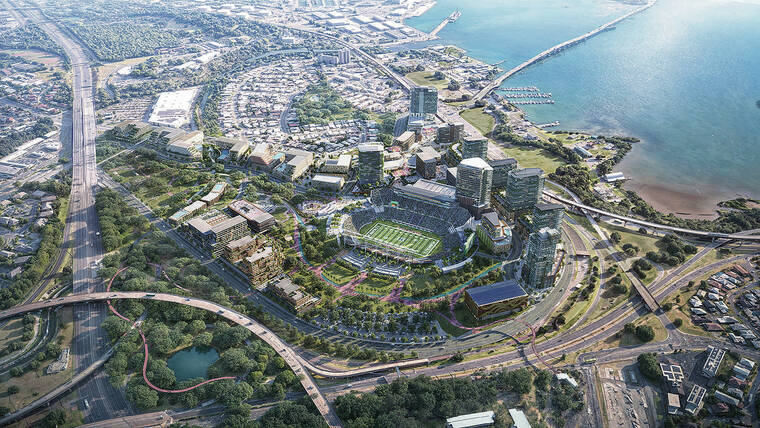By Dave Reardon
Copyright staradvertiser

Now, with pesky paperwork out of the way, it’s time for the heavy lifting to begin.
And if all goes according to plan, the new Aloha Stadium will be open for business in 2029, the centerpiece of the first phase of the New Aloha Stadium Entertainment District.
Two contracts signed Tuesday give NASED’s private partnership group, Aloha Halawa District Partners, the go-ahead to dismantle the old stadium and build the new one at the same site. The done deals were officially announced at Thursday’s monthly meeting of the Aloha Stadium Authority board.
“These agreements are a big step forward for Hawaii,” Stadium Authority Chair Eric Fujimoto said. “We hope generations of those with Hawaii in their hearts will come here to dream, celebrate and make lasting memories …”
The board authorized interim stadium manager Chris Sadayasu to sign the agreement with AHDP last month. But what was described as legalese by officials needed final review before pen could go to paper.
But now it is official that AHDP receives $350 million approved in 2022 by the Legislature for stadium construction. The deal also give AHDP the responsibilites and opportunities that go with master developer status for 73 acres around the 20-acre Halawa stadium site. The public-private partnership plan means the state taxpayers won’t be asked for further funding.
“We’re excited. It’s been a long haul,” developer Stanford Carr of AHDP said. “It will be a place where people can live, work, play and thrive. Let’s do it.”
Hazardous material abatement is the first step at the stadium site before major dismantlement of the old facility can begin in November. Dismantling is expected to be completed by June next year.
During that time, AHDP, with state oversight, will continue working on designing, building, operation and maintenance plans for the stadium.
“Today’s agreements are an encouraging milestone for the new Aloha Stadium and the future of UH athletics,” University of Hawaii Athletic Director Matt Elliott said. “While there is still much work ahead, the progress being made gives all of us reason to be optimistic. We are excited to see the momentum building and remain committed to doing our part to bring this long-awaited vision to life.”
Aloha Stadium was the home of UH football from its opening in 1975 to its 2020 closing. The Warriors, who have since played home games at the on-campus Ching Complex, are slated to return to Halawa when the new stadium is built.
“We also hope to see some big (music) acts again,” Sadayasu said.
The Cordish Companies are part of AHDP, and AHDP has publicly presented a concept called Aloha Live! It will be similar in some ways to other sports and entertainment districts Cordish has developed around the country.
“Our districts, such as Ballpark Village in St. Louis and Xfinity Live! in Philadelphia, transform stadium areas into year-round destinations to play, live and work,” according to information at cordish.com website. “At the core of each is our Live! experience which features immersive restaurants, dining, and sports-viewing options.”
Carr has presented renderings, and schematics are still in the works, he said Thursday.
Hawaiian Dredging will be a visible AHDP partner in the near future, as it works on the dismantlement.
It will cost signficantly more than the $350 million from the Legislature to build the 22,500-seat stadium (expandable to 45,000) envisioned by planners, but AHDP hopes to make up the difference as quickly as possible with a wide variety of real estate, including restaurants, shops and 4,500 residential units.
“Revenue earned by the NASED developer from the development of the remainder of the site and revenue earned from the operation of the new Aloha Stadium would be used to pay for stadium operations, including long-term capital maintenance, as well as to pay back any private financing obtained by the NASED developer,” according to the project’s informational website at nased.hawaii.gov.
The two signed contracts are the stadium development and operation agreement and the initial ground lease. Two more contracts need to be finalized and signed to authorize other NASED work.
This won’t prevent other parts of NASED to be built as part of the project’s first phase, board members said. Carr also is on record saying the stadium won’t be the only building in the first phase.
Even before he was elected in 2022, Gov. Josh Green has been a consistent NASED supporter — under the condition that it include significant affordable housing units.
“Housing will be part of the initial phase,” Fujimoto said.
All proposed construction will come before the Stadium Authority board for approval.
“There will be no car dealerships, no red light district,” Fujimoto said.
The board also announced a concert for Oct. 25 in the stadium parking lot, before the heavy lifting of dismantling begins.
“This is one single procurement,” NASED program director David Harris said. “The hard work really starts now.”



